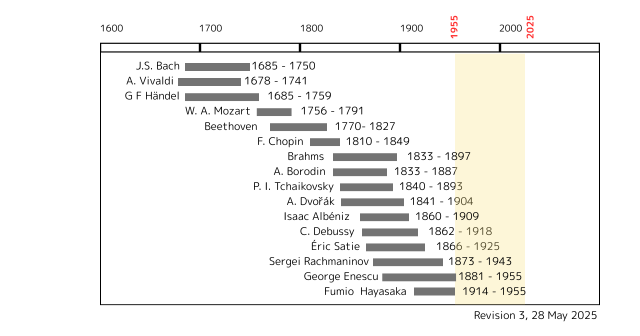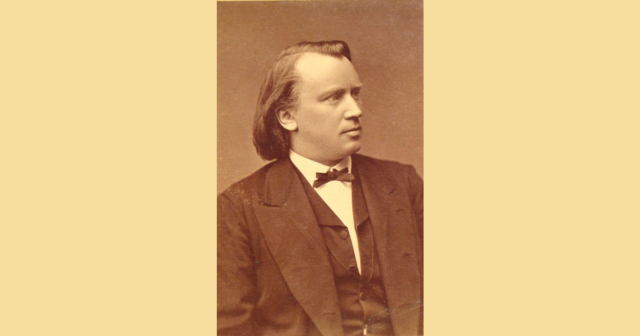The featured image is a portrait of Johannes Brahms around the age of 43, taken in 1876. The source is Wikipedia’s entry on *Symphony No. 1 (Brahms)* and public domain archives.
The Symphony No. 1 in C minor, Op. 68 was composed by the German composer Johannes Brahms. It premiered on November 4, 1876, in Karlsruhe—then part of the Grand Duchy of Baden—under the baton of Brahms’ friend, Felix Otto Dessoff.
This symphony has often been referred to as “Beethoven’s Tenth,” a testament to its high critical acclaim. Thanks to its accessible structure, famously described as “from darkness to light,” it is performed more frequently than Brahms’ later, more introspective symphonies—making it his most frequently played symphonic work.
While symphonies typically take months or a few years to compose, Brahms spent a staggering 21 years developing this work. Though not a slow composer by nature, Brahms was profoundly conscious of the legacy of Beethoven’s nine symphonies, which deeply influenced his approach to this first one.
Even entering the first 38 bars of the piece into MuseScore reveals Brahms’ meticulous craftsmanship. The delicate layering of winds and strings, the strategic use of percussion, and the development beyond Beethoven’s style are all evident. Especially striking is the handoff of melodic lines—from woodwinds to horn, and then to the cello—executed with breathtaking precision and expressive depth.
This post focuses on the opening 38 measures, but future uploads will gradually expand on the symphony, culminating in a revised and extended version.
Johannes Brahms (May 7, 1833 – April 3, 1897) was a German composer, pianist, and conductor. Together with J.S. Bach and Beethoven, he is considered one of the “Three Bs” of German classical music. Born in Hamburg and passing away in Vienna, Brahms’ music is generally classified as Romantic, yet he remained deeply committed to the formal beauty of Classical tradition.

アイキャッチ画像は、1876年当時43歳頃のヨハネス・ブラームスの肖像写真です。出典はWikipedia「交響曲第1番(ブラームス)」(パブリックドメイン)
交響曲第1番 ハ短調 作品68は、ドイツの作曲家ヨハネス・ブラームスによって作曲されました。初演は1876年11月4日、当時バーデン大公国に属していたカールスルーエにて、作曲者の友人フェリックス・オットー・デッソフの指揮により行われました。
この作品は「ベートーヴェンの交響曲第10番」と称されるほど高く評価されており、「暗から明へ」という明快な構成ゆえに、第2番以降の内省的な交響曲よりも演奏される機会が多く、ブラームスの交響曲の中で最も親しまれている作品となっています。
通常、交響曲の作曲には数か月から数年を要しますが、この第1番は着想から完成までに実に21年もの歳月が費やされました。遅筆ではなかったブラームスが、ここまで時間をかけた背景には、ベートーヴェンの偉大な9つの交響曲の存在が大きく影響していました。
冒頭のわずか38小節をMuseScoreに打ち込んだだけでも、ブラームスの音楽に対する恐るべきまでの拘りを実感することができます。管楽器と弦楽器の繊細な重ね合わせ、打楽器の効果的な用い方にはベートーヴェンからの発展が見られます。ソロパートでは、木管から金管ホルン、さらにチェロへと受け継がれる旋律の精巧な構成と豊かな表情が、聴く者に深い感動を与えます。
この投稿では、まず冒頭の38小節を取り上げますが、今後は打ち込みの範囲を徐々に広げ、改訂版を投稿していく予定です。
ヨハネス・ブラームス(Johannes Brahms, 1833年5月7日 – 1897年4月3日)は、ドイツの作曲家・ピアニスト・指揮者であり、J.S.バッハ、ベートーヴェンと並んで「ドイツ音楽の三大B」として称えられています。ハンブルクに生まれ、ウィーンにて生涯を終えました。その作風はロマン派に属しつつも、古典主義の形式美を重んじる特徴を持っています。

コメント